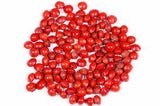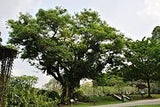- Store
- >
- Medicinal Plants
- >
- 15 Red 'Sandalwood' Seeds, Lal Chandan, Adenanthera Pavonina, India
15 Red 'Sandalwood' Seeds, Lal Chandan, Adenanthera Pavonina, India
'Lucky Red' seeds. AKA: Acacia Coral, Arbre À Église, Bead Tree, Circassian Seed, Corail Végétal, Coral Wood, madhoshi, Coralitos, Curly Bean, Deleite, Delicia, Dilmawi, Graine-réglisse, Jumbi-Bead, L'Église, Peronías, Peonía, Peonía Extranjera, Piriquiti, Red Bead Tree, and Réglisse. Barbados pride, Peacock flower fence, Sandalwood tree, Saga, and Manchadi are additional common names. Legume family. South Florida, Texas and California. No frost.
This tropical tree is fast-growing, with an attractive, spreading canopy that makes it suitable as a shade tree, and for ornamental purposes in large gardens or parks. However, it is also known for producing much litter in the form of leaves, twigs and seed pods.
The young leaves can be cooked and eaten. The raw seeds are toxic, but may be eaten when cooked.
Adenanthera pavonina seeds have long been a symbol of good luck and love in China, the "mutual love bean." The beauty of the seeds has led to them being used as beads in jewelry. The seeds were used as units of weight for fine measures (such as gold and silver) throughout history because the seeds are consistently identical in weight.
This tree is used for making soap, and a red dye can be obtained from its wood. The wood, which is extremely hard, is also used in boat-building, making furniture and for firewood.
Used traditionally to treat diarrhea, and as an anti-inflammatory and anti-bacterial agent.



